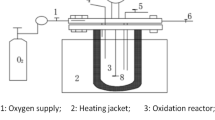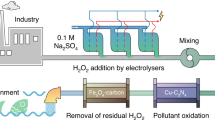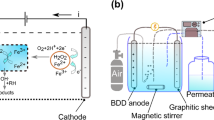Abstract
We describe a new technology for the destructive treatment of pharmaceutical wastes, the MODAR supercritical water oxidation process, that offers the advantages of almost complete destruction of organic matter coupled with a reasonable cost. We report the use of a bench-scale unit to treat a simulated chemical waste stream, a fermentation broth and a culture of an extreme thermophilic bacteria. Only inorganic compounds and simple organic materials, such as carbon dioxide, could be detected in the treated effluents.
This is a preview of subscription content, access via your institution
Access options
Subscribe to this journal
Receive 12 print issues and online access
$209.00 per year
only $17.42 per issue
Buy this article
- Purchase on Springer Link
- Instant access to full article PDF
Prices may be subject to local taxes which are calculated during checkout
Similar content being viewed by others
References
Modell, M. 1982. U.S. Patent 4,338,199, Processing methods for the oxidation of organics in supercritical water.
Timberlake, S.H., Hong, G.T., Simson M., Modell M. . 1982. Supercritical water oxidation for waste water treatment: Preliminary study of urea destruction, in Society of Automotive Engineers Technical Paper, Series No. 820872. (Society of Automotive Engineers: Warren-dale, PA).
Modell, M., Gaudet, G.G., Simson, M., Hong, G.T., Biemann K. . Supercritical water: Testing reveals new process holds promise. Solid Wastes Management August, 1982.
Josephson, J. 1983. Supercritical fluids. Environ. Sci. Tech. 16:548a–551a.
Thomason, T.B. and Modell M. . 1984. Supercritical water destruction of aqueous wastes. Hazardous Waste 1:453–467.
Shatzman, A., Ho Y.S. and Resenberg M. . 1983. Use of phage of phase λ regulatory signals to obtain efficient expression of genes in Escherichia coli . Methods Enzymol. 101:123–138.
Young, J.F., Hockmeyer W.T., Gross M., Ballou W.R., Wirtz R.A., Trosper J.H., Beaudoin R.L., Hollingdale M.R., Miller L.H., Diggs C.L. and Rosenberg M. 1985. Expression of Plasmodium falciparum circumsporozoite proteins in Escherichia coli for potential use in a human malaria vaccine. Science 228:958–962.
Beaman, T.C., Greenamyre J.T., Corner T.R., Pankratz H.S. and Gerhardt P. . 1982. Bacterial spore heat resistance correlated with water content, wet density, and protoplast/sporoplast volume ratio. J. Bacteriol. 150:870–877.
Shivvers, D.W. and Brock T.D. . 1973. Oxidation of elemental sulfur by Sulfolobus acidocaldarius . J. Bacteriol. 114:706–710.
Francisco, D.E., Mah R.A. and Rabin A. . 1973. Acridine orangeepifluorescence technique for counting bacteria in natural waters. Trans. Amer. Micros. Soc. 92:416–421.
Hobbie, J.E., Daley R.J. and Jasper S. . 1977. Use of nuclepore niters for counting bacteria by fluorescence microscopy. Appl. Environ. Microbiol. 33:1225–1228.
Smith, P.K., Krohn R.I., Hermanson G.T., Mallia A.K., Gartner F.H., Provenzano M.D., Fujimoto E.K., Goeke N.M., Olson B.J. and Klenk D.C. . 1985. Measurement of protein using bicinchoninic acid. Anal. Biochem. 150:76–85.
Kaushal, V. and Barnes L.D. . 1986. Effect of zwitterionic buffers on measurement of small masses of protein with bicinchoninic acid. Anal. Biochem. 157:291–94.
Dubois, M., Gilles K.A., Hamilton J.K., Rebers P.A. and Smith F. . 1956. Colorimetric method for determination of sugars and related substances. Anal. Chem. 28:350–356.
U.S.Enironmental protection Agency. 1984 Methods for organic chemical analysis of municipal and industrial wastewater: Method 625- base/neutrals and acids. Federal Register 49 (209) October 26:153–162.
Merck Index,9th Ed.1976 Trichloroacetic acid, 1236.
U.S.Environmental protection Agency. 1984 Methods for organic chemical analysis of municipal and industrial wastewater: Method 601—Purgeable halocarbons. Federal Register 49 (209) October 26:29–39.
Nelson Analytical. 1986 TECON software. (Nelson Analytical: Cupertino, CA).
Briggs, A. 1966 The resistances of spores of the genus Bacillus to phenol, heat and radiation. J. Appl. Bact. 29:490–504.
Sturm, F.J., Hurwitz S.A., Deming J.W. and Kelly R.M. . 1988. Growth of the extreme thermophile Sulfolobus acidocaldarius in a hyperbaric helium bioreactor. Biotech. Bioeng., In the press.
Author information
Authors and Affiliations
Rights and permissions
About this article
Cite this article
Johnston, J., Hannah, R., Cunningham, V. et al. Destruction of Pharmaceutical and Biopharmaceutical Wastes by the Modar Supercritical Water Oxidation Process. Nat Biotechnol 6, 1423–1427 (1988). https://doi.org/10.1038/nbt1288-1423
Issue Date:
DOI: https://doi.org/10.1038/nbt1288-1423



